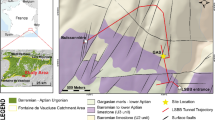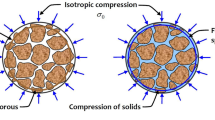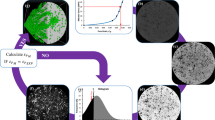Abstract
The electrical transport of saturated porous rocks has been studied in 3-dimensions for five different channel geometries. The five selected geometries can form the de-constructed parts of any real transport channel in reservoir rocks. The average cross-sectional area and effective length of each of the channels have been computed to construct the geometric factor. The electrical properties studied showed a quadratic increase with increase in clay fraction in the channel with surface conductivity emerging as the major contributor responsible for conductivity at clay fraction \(\sim\) 0.5 and above. The role of clay conductance in electrical transport was investigated for the different geometries. Variations in pore throat size corresponded to non-linear shifts in effective conductivity with clay conductance, in contrast to the linear increase observed for uniform pore throat size. Channel structures with inverse gradients in flow paths, showed significantly lower electrical conductivity. Structures with more than one parallel path displayed higher electrical conductivity.





Similar content being viewed by others
Data Availablity
The author confirms that the data supporting the findings of this study are available within the article.
References
Ammar AI (2021) Development of numerical model for simulating resistivity and hydroelectric properties of fractured rock aquifers. J Appl Geophy 189:104319
Archie GE (1942) The electrical resistivity log as an aid in determining some reservoir characteristics. Trans AIME 146:54–62
Ayodele AL, Pamukcu S, Agbede OA (2020) Plasticity modification of a tropical laterite by electrochemical stabilization. Electrochim Acta 341:136047
Bakar WZW, Saaida IM, Ahmad MR, Amira Z, Mahat SQA (2019) Derivation of formation factor in shaly sandstone with geometry and clay conductivity effects. J Pet Sci Eng 182:106359
Berg CF, Kennedy WD, Herrick DC (2022) Conductivity in partially saturated porous media described by porosity, electrolyte saturation and saturation-dependent tortuosity and constriction factor. Geophys Prospect 70:400–420
Bernabé Yd, Revil A (1995) Pore-scale heterogeneity, energy-dissipation and the transport- properties of rocks. Geophys Res Lett 22:1529–1532
Bernard ML, Zamora M, Géraud Y, Boudon G (2007) Transport properties of pyroclastic rocks from montagne pelée volcano (martinique, lesser antilles). J Geophys Res 112:B05205
Brovelli A, Cassiani G, Dalla E, Bergamini F, Pitea D, Binley AM (2005) Electrical properties of partially saturated sandstones: novel computational approach with hydrogeophysical applications. Water Resour Res 41:W08411
Bourlange S, Henry P, Moore JC, Mikada H, Klaus A (2003) Fracture porosity in the décollement zone of Nankai accretionary wedge using logging while drilling resistivity data. Earth Planet Sci Lett 209:103–112
Bultreys T, Offenwert SV, Goethals W, Boone MN, Aelterman J, Cnudde V (2022) X-ray tomographic micro-particle velocimetry in porous media. Physics of Fluids 34:042008
Bussian AE (1983) Electrical conductance in a porous medium. Geophysics 48:1258–1268
Cabalar AF, Khalaf MM, Karabash Z (2018) Shear modulus of clay-sand mixtures using bender element test. Acta Geotech Slov 15:3–15
Cabalar AF, Suleyman D, Khalaf MM (2021) Liquefaction resistance of different size/shape sand-clay mixtures using a pair of bender element-mounted molds. J Test Eval 491:509–524
Cevika A, Sezer EA, Cabalar AF, Gokceogluc C (2011) Modeling of the uniaxial compressive strength of some clay-bearing rocks using neural network. Appl Soft Comput 11:2587–2594
Choo H, Song J, Lee W, Lee C (2016) Effects of clay fraction and pore water conductivity on electrical conductivity of sand-kaolinite mixed soils. J Pet Eng 147:735–745
Couto N, Ferreira AR, Lopes V, Peters SC, Mateus EP, Ribeiro AB, Pamukcu S (2020) Electrodialytic recovery of rare earth elements from coal ashes. Electrochimica Acta 359:136934
Dalla E, Cassiani G, Brovelli A, Pitea D (2004) Electrical conductivity of unsaturated porous media: pore-scale model and comparison with laboratory data. Geophys Res Lett 31:L05609
Friedman SP, Seaton NA (1998) Critical path analysis of the relationship between permeability and electrical conductivity of three-dimensional pore networks. Water Resour Res 34:1703–1710
Ghanbarian B, Hunt AG, Ewing RP, Skinner TE (2014) Universal scaling of the formation factor in porous media derived by combining percolation and effective medium theories. Geophys Res Lett 41:3884–3890
Glover P (2009) What is the cementation exponent? A new interpretation. Lead Edge 28:82–85
Glover PWJ (2016) Archie’s law–A reappraisal. Solid Earth 7:1157–1169
Gomes HI, Dias-Ferreira C, Ribeiro AB, Pamukcu S (2014) Influence of electrolyte and voltage on the direct current enhanced transport of iron nanoparticles in clay. Chemosphere 99:171–179
Hunt AG, Ewing RP, Ghanbarian B (2014) Percolation theory for flow in porous media, 3rd edn. Springer, Berlin
Jouniaux L, Zamora M, Reuschle T (2006) Electrical conductivity evolution of non-saturated carbonate rocks during deformation up to failure. Geophys J Int 167:1017–1026
Kadkhodaie A, Rezaee R (2016) A new correlation for water saturation calculation in gas shale reservoirs based on compensation of kerogen-clay conductivity. J Petr Sci En 146:932–939
Knudsen HA, Fazekas S (2006) Robust algorithm for random resistor networks using hierarchical domain structure. J Comput Phys 211:700–718
Langlois V, Trinh VH, Perrot C (2019) Electrical conductivity and tortuosity of solid foam: effect of pore connections. Phys Rev E 100:013115
Lemaitre J, Troadec JP, Bideau D, Gervois A, Bougault E (1988) The formation factor of the pore-space of binary-mixtures of spheres. J Phys D 21:1589–1592
Li KW, Pan BZ, Horne R (2015) Evaluating fractures in rocks from geothermal reservoirs using resistivity at different frequencies. Energy 93:1230–1238
Moshier SO (1989) Microporosity in micritic limestones: a review. Sediment Geol 63:191–213
Mualem Y, Friedman SP (1991) Theoretical prediction of electrical-conductivity in saturated and unsaturated soil. Water Resour Res 27:2771–2777
Olsen PA (2011) Coarse-scale resistivity for saturation estimation in heterogeneous reservoirs based on Archie’s formula. Geophysics 76:E35–E43
Øren PE, Bakke S (2003) Reconstruction of Berea sandstone and pore-scale modelling of wettability effects. J Pet Sci Eng 39:177–199
Paranthaman R, Azam S, Chowdhury RH (2024) Geotechnical evaluation of consolidation and conductivity of synthetic municipal solid waste. Geotech Geol Eng. https://doi.org/10.1007/s10706-024-02787-4
Prifling B, Roding M, Townsend P, Neumann M, Schmidt V (2021) Large-scale statistical learning for mass transport prediction in porous materials using 90,000 artificially generated microstructures. Front Mater 8:786502
Rivero OG (1977) Some considerations about the possible use of the parameters a and as a formation evaluation tool through well logs SPWLA 18th annual logging symposium. Texas June 1977, Houston
Revil A, Glover PWJ (1997) Theory of ionic-surface electrical conduction in porous media. Phys Rev B 55:1757–1773
Revil A, Glover PWJ (1998) Nature of surface electrical conductivity in natural sands, sandstones, and clays. Geophys Res Lett 25:691–694
Roubinet D, Irving J (2014) Discrete-dual-porosity model for electric current flow in fractured rock. J Geophys Res Solid Earth 119:767–786
Roubinet D, Irving J, Pezard PA (2018) Relating topological and electrical properties of fractured porous media: insights into the characterization of rock fracturing. Minerals 8:14
Qi W, Wu Y (2021) Electrical conductivity of clayey rocks and soils: a non-linear model. Geophys Res Lett 49:e2021GL097408
Sadhukhan S, Dutta T, Tarafdar S (2007) Pore structure and conductivity modelled by bidisperse ballistic deposition with relaxation. Modelling Simul Mater Sci Eng 15:773–786
Sadhukhan S, Dutta T, Tarafdar S (2007) Simulation of diagenesis and permeability variation in two-dimensional rock structure. Geophys J Int 169:1366–1375
Sahimi M (2011) Flow and transport in porous media and fractured rock: from classical methods to modern approaches, 2nd edn. Wiley, Weinheim
Salem HS (1993) Derivation of the Cementation Factor (Archie’s Exponent) and the Kozeny-Carman constant from well log data and their dependence on lithology and other physical parameters. SPE 26309
Santos JE, Yin Y, Jo H, Pan W, Viswanathan H, Prodanovic M, Pyrcz M, Lubbers N (2021) Computationally efficient multiscale neural networks applied to fluid flow in complex 3D porous media. Transp Porous Media 140:241–247
Singha K, Gorelick SM (2006) Hydrogeophysical tracking of three-dimensional tracer migration: the concept and application of apparent petrophysical relations. Water Resour Res 42:W06422
Swanson RD, Singha K, Day-Lewis FD, Binley A, Keating K, Haggerty R (2012) Direct geoelectrical evidence of mass transfer at the laboratory scale. Water Resour Res 48:W10543
Telford WM, Geldart LP, Sheriff RE (1990) Applied geophysics, 2nd edn. Cambridge University Press, England, p 283
Thompson AH, Katz AJ, Krohn CE (1987) The microgeometry and transport properties of sedimentary rock. Adv Phys 36:625–694
Wang H, Liu Y, Song Y, Zhao Y, Zhao J, Wang D (2012) Fractal analysis and its impact factors on pore structure of artificial cores based on the images obtained using magnetic resonance imaging. J Appl Geophys 86:70–81
Wang YD, Chung T, Armstrong RT, Mostaghimi P (2021) ML-LBM: predicting and accelerating steady state flow simulation in porous media with convolutional neural networks. Transp Porous Media 138:49–75
Whitehead R, Schreyer L, Akin I (2024) A multi-scale model of overburden pressure and water content in montmorillonite-bearing clayey soils. Geotech Geol Eng. https://doi.org/10.1007/s10706-024-02761-0
Wildenschild D, Sheppard AP (2013) X-ray imaging and analysis techniques for quantifying pore-scale structure and processes in subsurface porous medium systems Adv. Water Resour 51:217–246
Winsauer WO (1952) Resistivity of brine-saturated sands in relation to pore geometry. AAPG Bull 36:253–277
Ye YX, Hu XY, Xu D (2015) A goal-oriented adaptive finite element method for 3D resistivity modeling using dual-error weighting approach. J Earth Sci 26:821–826
Yu M, Gui Y, Laguna R (2023) Hydraulic conductivity characteristics of a clayey soil incorporating recycled rubber and glass granules. Water. https://doi.org/10.3390/w15112028
Zhao J, Sun J, Liu X, Chen H, Cui L (2013) Numerical simulation of the electrical properties of fractured rock based on digital rock technology. J Geophys Eng 10:055009
Acknowledgements
The author is grateful to Tapati Dutta for stimulating suggestions and discussions on the subject.
Funding
The author declares that no funds, grants, or other support were received during the preparation of this manuscript.
Author information
Authors and Affiliations
Corresponding author
Ethics declarations
Conflict of interest
The author has no Conflict of interest to declare that are relevant to the content of this article.
Additional information
Publisher's Note
Springer Nature remains neutral with regard to jurisdictional claims in published maps and institutional affiliations.
Rights and permissions
Springer Nature or its licensor (e.g. a society or other partner) holds exclusive rights to this article under a publishing agreement with the author(s) or other rightsholder(s); author self-archiving of the accepted manuscript version of this article is solely governed by the terms of such publishing agreement and applicable law.
About this article
Cite this article
Sadhukhan, S. 3D Pore Geometry and Electrical Conductivity. Geotech Geol Eng (2024). https://doi.org/10.1007/s10706-024-02803-7
Received:
Accepted:
Published:
DOI: https://doi.org/10.1007/s10706-024-02803-7




